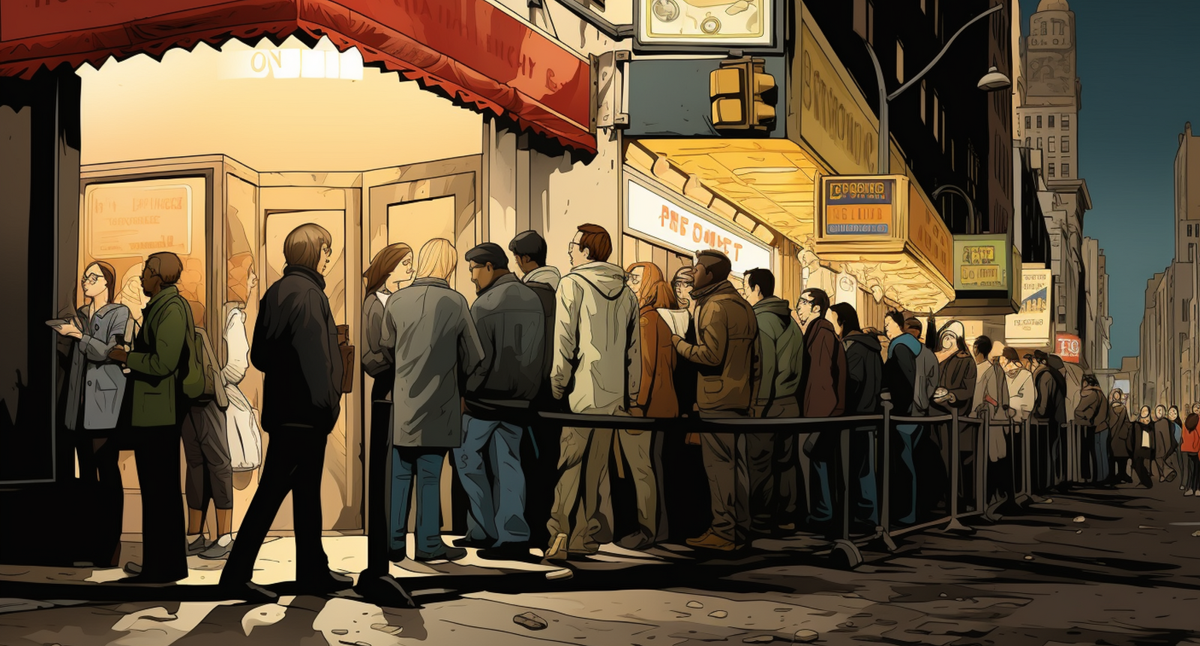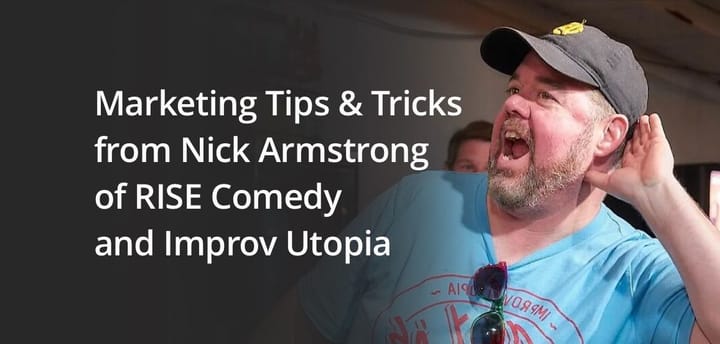What Drives Event Attendance?

Listen, in the world of showbiz, you'd think that landing a gig, nailing the lines, or perfecting that punchline is the hardest part, right? Not so fast, my friend. Sure, those matter, but what's a performance without an audience? You might as well practice at home. But seriously, understanding what brings a crowd to your venue is crucial. It's the butter to your popcorn and the lifeblood of your business.
Think about it: no performer dreams of delivering Hamlet's "To be or not to be" soliloquy to empty seats or cracking up their best jokes to a room so silent you can hear a pin drop. If no one is around to watch a performance, did it really happen? Understanding what drives attendance isn't just nice-to-have knowledge like knowing all the lyrics to "Bohemian Rhapsody" (though that's impressive, I admit). No, it's essential; it's the lifeline of the performing arts world. Let's take a delightful saunter down memory lane, shall we? Once upon a time, before Netflix and chill, people gathered in big, fancy buildings, all hushed whispers and rustling playbills, waiting for a thrilling tale to unfold before their very eyes. That's right; we're talking about the grand ol' tradition of theatre we harp on in these articles. These performances continue today, so what can theatres and clubs do to compete with the new couch potato streaming services? The age of Netflix, Hulu, HBO Max, and others is upon us, where you can binge-watch entire seasons of shows from the comfort of your couch, sans pants if that's your thing. According to a report by the Pew Research Center, as of 2021, about 80% of American adults reported they subscribe to some form of streaming service. Yes, you read it right, 80%! "But wait!" I hear the theatre purists cry, "What about the thrill of live performance, the raw energy of actors on stage, the shared laughter in a comedy club?" While the rise of streaming platforms has indeed revolutionized how we consume entertainment, it hasn't meant curtains for theatre and improv comedy. Far from it, in fact, the year before the Covid pandemic was an all-time high for Broadway show admission sales.
Remember the Pokemon Go craze in 2016? With children and strangely many adults roaming the streets searching for geo-located ‘pokemans’? Well, that game alone caused 71% of 500 respondents in a SLANT survey to admit that it was the only reason they went to certain venues. 51% of those respondents visited a venue for the first time because of that game. Isn’t that amazing? Pokemon Go collaborated with McDonald’s and Sprint, tagging over 10,000 of the former as POI (Places Of Interest) in the app and over 3,000 locations of the latter. The McDonald’s that became POIs attracted an estimated 2,000 players per day, some increasing their sales by 100%! Snapchat also collaborates with companies to make certain filters only accessible by actually visiting a physical location, seeing similar eye-popping attendance increases (although not as crazy as Pokemon). Wendy’s saw an increase of 42,000 patrons in the first week alone. Other businesses have implemented similar augmented offers with great results. Believe it or not, the worldwide AR/VR market is roughly 25 billion dollars and is projected to be over 200 billion dollars by 2030. Although, interestingly, we’ve noticed this projection keeps getting moved ahead every year.
Ever find yourself wanting to step out of your daily routine for a bit, maybe take a jaunt into Elizabethan England, or visit a galaxy far, far away? You're not alone. One big factor driving attendance specifically to theatrical venues is that unique escapism theatre and improv comedy offers a sort of magic portal away from mundane chores and pesky emails. So hey, don't underestimate the allure of a little stardust.
Now, everyone loves a good recommendation, don't they? Reviews and word-of-mouth buzz are the bread and butter of show attendance. This can absolutely not be understated, gossip is human nature. A 2021 survey by Medium found that 46% of respondents trusted television ads, tying with print, and radio coming in just behind.
https://www.statista.com/statistics/325458/trustworthiness-common-advertising-tactics
But can you guess what communication medium drives five times more sales than a paid media impression? It’s that big hole in everyone’s face. Word of mouth accounts for over six trillion dollars of consumer spending annually. We're 90% more likely to trust our peers over advertising. That's right, your Aunt Karen's rave review about that hilarious improv show holds more sway than a flashy billboard or primetime ad, by far.
This brings up an important point, it's not just about posters and TV spots anymore. Social media and online platforms are the new frontiers of theatre and comedy promotion. If your venue doesn’t have an active web presence on a social platform, you’re leaving a massive chunk of pie on the table. Luckily Fourth Wall Tickets allows you to make simple yet captivating landing pages for each show and class, or all of your events. Learn to leverage your social presence and your newfound knowledge of word of mouth to fill those seats!
There's also something uniquely irresistible about improv comedy - the lure of participation. Let's be honest, who doesn't love a bit of audience interaction, especially when you get to shout out suggestions and see them woven into the show on the spot? Had a rough week? Shout it out and laugh at it. It's like being part of a personal magic trick. Finally, let's not underestimate the desire for cultural and intellectual enrichment. In a world of 280-character tweets and TikTok videos, theatre and comedy offer a rich tapestry of cultural insights and thought-provoking themes. Speaking of culture, it pays to know the secret to understanding the demographic puzzle. Let's take a look.
First off, age and generational differences. While you might picture the average theatergoer as a sophisticated elderly woman sipping on a glass of champagne, you'd be surprised! The average age of a comedian is 30-40 years old
and they typically bring a crowd in the same age bracket. In terms of improv, Millennial and Gen Z crowds are increasingly drawn to the raw, unscripted hilarity of improv comedy. And let's not forget, they're also more likely to share their experiences on social media, sparking that word-of-mouth buzz we mentioned earlier.
What about socioeconomic factors? As much as we'd all love a carefree splurge on the best seats for "Hamilton," the reality is that ticket prices can be a significant hurdle. Statistics indicate that higher income households are more likely to attend theatre performances. This seems obvious, but it’s a valuable nugget to remember. On the flip side, improv clubs, with their more affordable tickets and even free shows, offer an enticing alternative for those wanting to stretch their entertainment dollars. Take notice of what neighborhood your theatre or club is in. Is the crowd older or younger? Richer or poorer?
Then there's the intriguing interplay of gender and cultural influences. For instance, Broadway League research suggests that women make up 68% of the Broadway audience. Why? Well, the theory is that women are more inclined to engage with narratives that delve into emotional depth and human relationships. This makes sense as women are typically better able to manage emotions both in themselves and in others. Also, culturally diverse productions have been drawing in wider and more varied audiences, reflecting our diverse society. The success of shows like "Hamilton," with its innovative casting and storytelling, is a testament to that.
Theatre and improv comedy have proven themselves to be nimble, creative, and resilient in the face of change (cue dramatic superhero music). With a plot twist worthy of a Shakespearean drama, many theatres and comedy clubs have turned to digital platforms not just as a challenge but an opportunity.
Let's take a look at two tales from the theatre world, almost like a "behind-the-scenes" reality TV show. Don't worry. I promise this won't involve any elimination rounds or voting off islands. First up, we have "Hamilton". You know, the small, humble Broadway show that only managed to bag a record-breaking 16 Tony nominations, 11 Tony wins, and a Pulitzer Prize. It was watched by over 2.6 million people in 2019 alone. Hamilton was the unique combination of a compelling narrative based on historical events, a refreshing and diverse cast, clever marketing, and of course, Lin-Manuel Miranda's sheer genius in storytelling through rap and hip-hop that made the show the giant success it is. And let's not forget the rave reviews it garnered from both critics and audiences alike. Hamilton redefined what a Broadway musical could be, and audiences showed up in droves for the experience. It’s a great case study for a successful production, and theatres that couldn’t afford to bring the production to their stages knew that riding the wave was better than fighting it. We saw hundreds of shows and skits across the country that played on the same themes budding up from smaller venues. No doubt that these subtle acknowledgements to the blockbuster Hamilton helped these venues stay ahead.
On the flip side, let's talk about "Carrie: The Musical." Yes, there was a musical based on Stephen King's horror novel and the subsequent film (talk about a niche market). It had a brief and not so illustrious run on Broadway in 1988, lasting only 5 performances after its official opening night before it was "dropped like a hot brick," as one critic eloquently put it. The issues? A narrative that didn't quite translate well to the stage, mixed reviews, and a failure to attract a substantial audience due to its unconventional theme (high school proms and telekinetic powers don't usually mix, right?).
What can we glean from these two case studies? Well, there's no one-size-fits-all formula for success, but understanding your target audience, current events, your venue’s local demographic, creating an engaging narrative, and effective marketing certainly seem to play a big role in drawing crowds. The year 2020 was a real showstopper, and not in the way we'd like. The COVID-19 pandemic hit the pause button on the world, and theatres and comedy clubs were certainly not immune. Theaters were silent, and comedy clubs were void of laughter, as audience seats remained sadly unwarmed. In the US, the Broadway League reported a loss of over $1.3 billion in ticket sales due to the pandemic in 2020.
But, just like any good improv artist knows, when the scene changes, you adapt. Many theatres and comedy clubs switched gears and went virtual, streaming live performances online. Comedians exchanged the live roar of laughter for heart emojis on screens, and theatre actors found themselves performing Shakespeare on Zoom in their living rooms, with the occasional cat cameo (or should we say catmeo?). The National Theatre in the UK reported over 15 million views from their National Theatre At Home initiative. So, not all was lost. As we step into a post-pandemic world, these lessons of resilience, adaptability, and innovation are hardwired into the DNA of our performing arts culture. Even in the face of the biggest disruption the modern world has seen, theatres and comedy clubs have shown that they can still draw an audience, albeit virtually. You know what they say, "All the world's a stage," or, in this case, "All the world's a screen." Luckily, the financial recovery is underway as in-person attendance continues trending back up to all-time high across the country. Just as a good stage production requires rehearsal, boosting theatre and comedy club attendance calls for a strategy. Remember, marketing is the director of this grand show. From flashy billboards to engaging social media campaigns, getting the word out is key. A survey from the Broadway League found that 41.6% of respondents learned about the show they attended from the Internet. So, if you want to fill those seats, you've got to get those tweets. That plays into audience engagement since engagement is more memorable, which again drives all the right gossip. After all, who wants to go to a show where they feel like just another face in the crowd or a piece of furniture? More and more, theatres and comedy clubs offer backstage tours, Q&As with the cast, or improvisation workshops. The goal is obvious: to remind the audience that they are part of the show and that their attention is well placed on the stage.
And remember to think of AR and VR, touchpoints for ticket sales, or interactive experiences during the show. Use tech to leverage that lovely engagement. Remember when they said phones had no place in theatres? Well, the tables have turned. There's a growing trend of "Tweet Seats," where audiences are encouraged to live-tweet their theatre experience. Just don’t forget to silence your phone.
When it comes to anticipated trends, we're in for an exciting time. With digital platforms vying for attention, theatres and comedy clubs will likely up the ante, bringing more immersive, interactive, and innovative experiences to the stage. The industry is predicted to grow at an annualized rate of 1.5% to $37.5 billion from 2021 to 2026, and improv comedy will definitely be cracking up a good chunk of that growth.
Creativity and innovation aren't just buzzwords here; they're the secret sauce for future attendance. Dig deep past your golden wrapper and hard, crunchy exterior to the creamy nougat center to find that hazelnut of fresh ideas. Yes, you are a Ferrero Rocher chocolate in this analogy; go with it. As we've seen during the pandemic, those who could pivot and adapt creatively could continue to engage audiences and vastly increase their online follower counts. Google was cited as the most common source for theatergoers, so Theatres will likely continue to offer more experiences that simply can't be replicated at home but lures people in through that first-touch experience over the web - like with multi-sensory shows or audience-directed plots.
So, as we stride into the future of theatre and improv comedy, one thing's for sure: it's not just about watching a show anymore; it's about experiencing it. So, let's see where the future takes us, and remember that Fourth Wall Tickets can always help you get there.
https://www.statista.com/statistics/325458/trustworthiness-common-advertising-tactics
https://arxiv.org/pdf/1903.10917.pdf
https://www.invespcro.com/blog/word-of-mouth-marketing/



